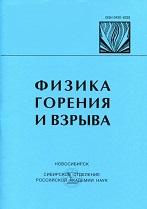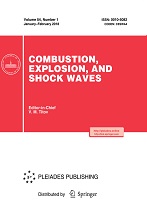|
This article is cited in 13 scientific papers (total in 13 papers)
Propagation and quenching of premixed flames in narrow channels
Z. B. Song, X. W. Ding, J. Yu, Y. Z. Chen
Institute of Chemical Engineering, Dalian University of Technology, Dalian, Liaoning, China
Abstract:
The shape and propagation of unsteady premixed flames in narrow channels with adiabatic and isothermal walls are numerically investigated in the present study. The flame chemistry is modelled by an one-step overall reaction, which simulates the reaction of a stoichiometric acetylene-air mixture. The numerical results show that both ignition methods and thermal boundary conditions affect flame formation and its shape. The flame keeps a single tulip shape in the whole process of propagating through the channel if plane ignition is used and a single mushroom shape if spark ignition is used. For isothermal cold walls, the flame cannot keep a single tulip shape or mushroom shape all the time. Under plane ignition, a transition from a tulip-shaped flame to a mushroom-shaped flame occurs as flames propagate from one end of channel to the other. Under spark ignition, the process is just the contrary. It is also shown that the heat loss at the cold walls has a dual effect on the formation of a tulip-shaped flame. Flame propagation and quenching in narrow channels of different heights are analyzed systematically, and a criterion is proposed to judge the flame states of partial extinction and total extinction. It is called the criterion of flame propagation and quenching in narrow channels.
Keywords:
narrow channel, tulip-shaped flame, mushroom-shaped flame, heat loss, quenching.
Received: 24.02.2005
Accepted: 27.04.2005
Citation:
Z. B. Song, X. W. Ding, J. Yu, Y. Z. Chen, “Propagation and quenching of premixed flames in narrow channels”, Fizika Goreniya i Vzryva, 42:3 (2006), 27–36; Combustion, Explosion and Shock Waves, 42:3 (2006), 268–276
Linking options:
https://www.mathnet.ru/eng/fgv1591 https://www.mathnet.ru/eng/fgv/v42/i3/p27
|


| Statistics & downloads: |
| Abstract page: | 34 |
|





 Contact us:
Contact us: Terms of Use
Terms of Use
 Registration to the website
Registration to the website Logotypes
Logotypes








 Citation in format
Citation in format 
